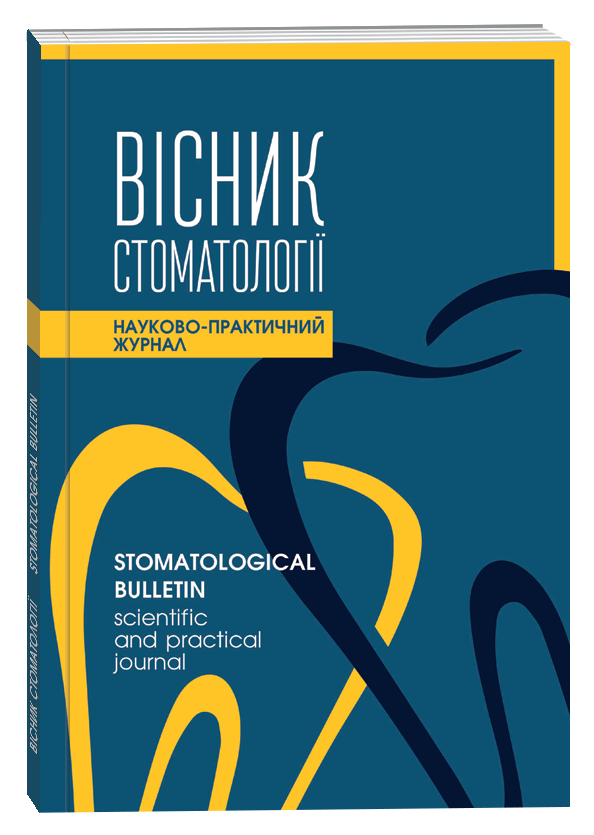IATROGENIC FACTORS IN THE DEVELOPMENT OF MYOFASCIAL SYNDROME
DOI:
https://doi.org/10.35220/2078-8916-2021-42-4.7Keywords:
iatrogenic, myofascial facial pain syndrome, temporomandibular joint, diagnosis, clinicAbstract
The aim of the study. Study of the frequency of dental iatrogeny in the polyetiology of myofascial facial syndrome and painful thyroid dysfunction. Material and methods. The analysis of anamnestic data of 97 patients who applied to the consultation room of the Department of Maxillofacial Surgery and Otolaryngology in the period from January 2020 to September 2021 was conducted. with symptoms of painful dysfunction of the temporomandibular joint in connection with the relationship between dental manipulations and the occurrence of pain in the temporomandibular joint. To achieve this goal, it was sufficient to determine the patient’s presence or absence of iatrogenic as a fact of medical intervention in the formation of the pathological condition. Scientific novelty. The development of the medical field is accompanied by the emergence of complex mechanisms for the treatment of dental diseases. In turn, new drug manipulations may contribute to the development of pathological conditions in some patients. At the present stage, it is of interest to study the role of iatrogenic in the etiology of current modern disease – myofascial facial syndrome. The first stage of the study will be to get an idea of the frequency of iatrogenic among the various causes of this pathological condition. Conclusions. Medical manipulations as the cause of the development of facial pain and TMJ are determined by 40.2% of subjects. In the group of patients of the youngest age (27.8±7.9 years) who sought help for the first time within 1.5 months. from the beginning of the disease in 100% of cases the cause of the disease is determined by medical manipulations; in this group of subjects more pronounced symptoms of joint pain of a local nature (100%). In the group of the oldest patients (55.2±9.8 years) and the chronic course of the disease is determined by the lowest rate of iatrogenic disease – 5.9%, in this group of subjects more pronounced symptoms of pain in the face (82.3%), muscles (82.3%) and signs of joint dysfunction (94.1%).
References
Pihut M, Szuta M, Ferendiuk E, Zeńczak-Więckiewicz D. Differential diagnostics of pain in the course of trigeminal neuralgia and temporomandibular joint dysfunction. Biomed Res Int. 2014; 2014: 563786. https://doi.org/10.1155/2014/563786
Calixtre LB, Grüninger BLS, Chaves TC, Oliveira AB. Is there an association between anxiety/depression and temporomandibular disorders in college students?J Applied Oral Sci. 2014; 22(1): 15–21. https://doi.org/10.1590/1678-775720130054.
Schiffman E, Ohrbach R, Truelove E, et al. Diagnostic criteria for Temporomandibular disorders (DC/TMD) for clinical and research applications: recommendations of the international RDC/TMD consortium network* and Orofacial pain special interest Groupdagger. J Oral Facial Pain Headache. 2014; 28(1): 6–27. https://doi.org/10.11607/jop.1151
Kmeid, E., Nacouzi, M., Hallit, S. et al. Prevalence of temporomandibular joint disorder in the Lebanese population, and its association with depression, anxiety, and stress. Head Face Med 16, 19 (2020). https://doi.org/10.1186/s13005-020-00234-2
Дисфункция ВНЧС (височно-нижнечелюстного сустава). Этиологические аспекты / И.В. Петрикас, В.И. Никаноров, Е.О. Петрикас и др. Sciences of Europe. 2018. № 1(26). С. 53–58.
Sampaio NM, Oliveira MC, Ortega AO, et al. Temporomandibular disorders in elderly individuals: the influence of institutionalization and sociodemographic factors. Codas. 2017; 29(2): e20160114. https://doi.org/10.1590/2317-1782/20162016114.
Гулюк С.А., Шнайдер С.А., Нонєва Н.О. Клінічні особливості оклюзії і функції СНЩС у хворих на міофасціальний больовий синдром обличчя. Вісник стоматології. 2019. Т. 32, № 2. С. 69–73. URL: http://nbuv.gov.ua/UJRN/VSL_2019_32_2_20









